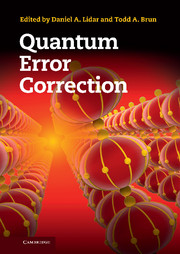Book contents
- Frontmatter
- Contents
- List of contributors
- Prologue
- Preface and guide to the reader
- Acknowledgements
- Part I Background
- Part II Generalized approaches to quantum error correction
- Part III Advanced quantum codes
- Part IV Advanced dynamical decoupling
- Part V Alternative quantum computation approaches
- Part VI Topological methods
- Part VII Applications and implementations
- 21 Experimental quantum error correction
- 22 Experimental dynamical decoupling
- 23 Architectures
- 24 Error correction in quantum communication
- Part VIII Critical evaluation of fault tolerance
- References
- Index
22 - Experimental dynamical decoupling
from Part VII - Applications and implementations
Published online by Cambridge University Press: 05 September 2013
- Frontmatter
- Contents
- List of contributors
- Prologue
- Preface and guide to the reader
- Acknowledgements
- Part I Background
- Part II Generalized approaches to quantum error correction
- Part III Advanced quantum codes
- Part IV Advanced dynamical decoupling
- Part V Alternative quantum computation approaches
- Part VI Topological methods
- Part VII Applications and implementations
- 21 Experimental quantum error correction
- 22 Experimental dynamical decoupling
- 23 Architectures
- 24 Error correction in quantum communication
- Part VIII Critical evaluation of fault tolerance
- References
- Index
Summary
Introduction and overview
As mentioned in Chapter 4, dynamical decoupling (DD) techniques have developed decades of tradition in the context of NMR spectroscopy, where they continue to play a pervasive role throughout all aspects of imaging and coherent control of multi-spin dynamics in the liquid and solid state. A dedicated experimental characterization and exploitation of DD as a tool for high-fidelity dynamical control and decoherence suppression in different quantum information processing (QIP) platforms has been undertaken only in more recent years, largely enabled by impressive laboratory progress in fast and ultrafast coherent control capabilities over the past decade. Without attempting to provide a comprehensive in-depth account, it is our goal in this chapter to highlight some key experimental advances to illustrate the significance of DD strategies for near-term practical quantum error control in QIP; and justify why, quoting from a recent experimental work [MTA+06], they “will likely form a quintessential element in real quantum computers.”
The large majority of dynamical error-suppression implementations in QIP have aimed thus far to validate DD as a tool for enhanced quantum memory in different qubit devices in the presence of various decoherence mechanisms. Likewise, with the exception of a recent work reporting the suppression of collisional decoherence using a “continuous spin echo” close in spirit to Eulerian DD [SAD10], the majority of experiments have employed (sufficiently) “hard” pulses, such that any evolution other than that due to the control field could be taken as negligible and the bang-bang (BB) limit formalized in Chapter 4 invoked as an adequate approximation.
- Type
- Chapter
- Information
- Quantum Error Correction , pp. 519 - 536Publisher: Cambridge University PressPrint publication year: 2013
- 2
- Cited by

